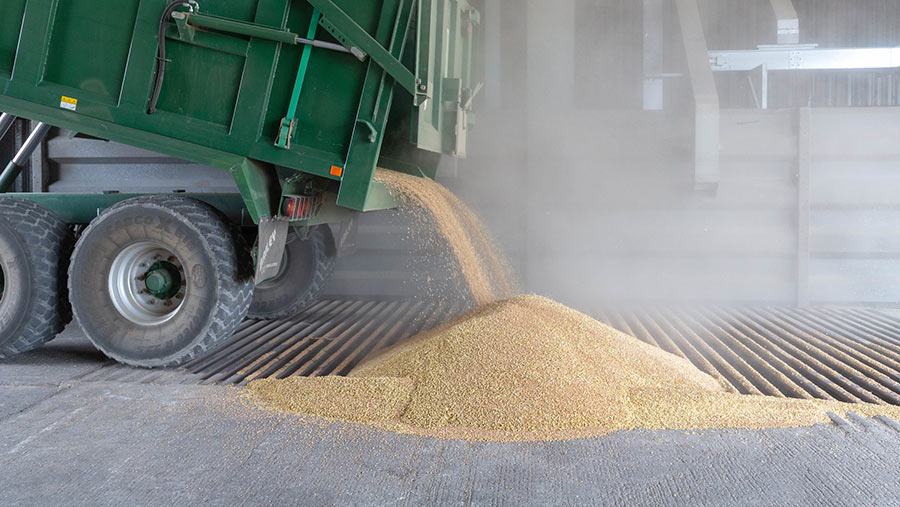Volatility the only certainty in grain and oilseeds markets
 © Tim Scrivener
© Tim Scrivener Markets are being driven by political and economic uncertainty, with the only sure thing this coming winter being a high degree of volatility.
That volatility is already attracting record levels of speculative investment in US farm commodity futures funds, driving further price movements.
Alongside the fundamentals of small UK wheat and oilseed rape crops, a bumper barley crop and huge competition from imported maize, currency is key, said AHDB analysts at the organisation’s virtual Grain Market Outlook event this week.
See also: £25m equipment grant opens for third and final time
Overlaying everything is the effect of Covid-19 on demand and markets, at home and abroad.
US election influence
The US election process and its effect on the value of the US dollar is one of the main market influences and growers should watch for market movement as a whole raft of economic data is released between now and the end of the year, they said.
In the UK, that includes manufacturing data, inflation, unemployment and GDP figures.
The raft of influences makes prices more difficult than ever to predict. AHDB senior analyst James Webster said: “Volatility is not always your enemy; where volatility influences the value of sterling and it falls, it offers opportunities to sell. ”
The 2020 wheat crop market has settled to a degree in the northern hemisphere, said Mr Webster, now that more is known about the crop, but with so many factors at play, the market could be pushed either way.
One of these factors is the speculative investment in agricultural commodity funds, which could reduce quickly if the Dow Jones index strengthened on better US economic news, he said.
On the domestic front, the drop in the size of the UK wheat harvest, alongside a bumper barley crop, resulted in the largest monthly barley-wheat price gap since 1975, at £44/t in September, said senior cereals and oilseeds analyst Helen Plant.
The AHDB puts the UK wheat crop at 9.8-9.9m tonnes against Defra’s recently announced 10.13m tonnes, although its analysts stressed that more information on regional performance was needed to allow a more confident estimate.
Barley use in feed has risen as a result of that price gap, to almost 13.5%. “But no matter how much barley is used, it won’t make up for the drop in wheat, so we expect maize to play a bigger role this year,” said Ms Plant.
Demand implications of new restrictions
This week’s new restrictions on pubs, bars and other venues in some areas mean that the slow recovery in malting barley use, which slumped on the March lockdown, is at risk.
Use levels had recovered to about 75% of normal rates in August and 80% in September, as demand rose over the summer. However, a return to full demand was unlikely anytime soon, said Ms Plant.
Other figures relating to domestic demand include chick placings, which are down slightly, possibly because of eating habit changes as a result of Covid-19.
In the wheat market, many domestic samples face a challenge in meeting full-spec breadmaking requirements, and imports of German wheat in July and August alone were at roughly half the total for the whole of last season, prompted not only by quality concerns, but also by the need to pull forward imports in advance of the end of the UK’s Brexit transition period on 31 December.
Factors influencing winter 2020 grain and oilseeds markets
- Currency volatility, exacerbated by US election, UK-EU trade talks, economic and Covid-19 numbers
- Covid-19 – depressed demand for many livestock and crop commodities, including maize for ethanol fuel, in turn making maize extremely competitive with wheat
- Heavy involvement of speculative money in agricultural funds – risk that this could change quickly
- Russia may have to rein back wheat exports early next year to protect its domestic consumers’ supply and prices – also dry drilling conditions for Black Sea area 2021 crops
- US-China trade – US soya bean exports to China at record levels in recent months, and also from Brazil, supporting soya bean prices in a global oilseeds market that is seeing tighter supplies for the second year in a row, with production below expected consumption levels
- Global trade prospects further unsettled by China-Australia and China-Canada trade disputes
- Lack of progress on UK-EU trade terms
